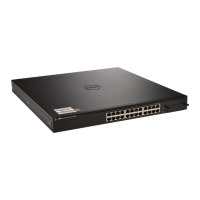68 Switch Features
Auto Negotiation
Auto negotiation allows the switch to advertise modes of operation. The auto
negotiation function provides the means to exchange information between
two switches that share a point-to-point link segment, and to automatically
configure both switches to take maximum advantage of their transmission
capabilities.
PowerConnect 8000/8100-series switches enhance auto negotiation by
providing configuration of port advertisement. Port advertisement allows the
system administrator to configure the port speeds that are advertised.
For information about configuring auto negotiation, see "Configuring Port
Characteristics" on page 451.
Broadcast Storm Control
When Layer 2 frames are forwarded, broadcast, unknown unicast, and
multicast frames are flooded to all ports on the relevant virtual local area
network (VLAN). The flooding occupies bandwidth, and loads all nodes
connected on all ports. Storm control limits the amount of broadcast,
unknown unicast, and multicast frames accepted and forwarded by the
switch.
For information about configuring Broadcast Storm Control settings, see
"Configuring Port-Based Traffic Control" on page 679.
Port Mirroring
Port mirroring monitors and mirrors network traffic by forwarding copies of
incoming and outgoing packets from up to four source ports to a monitoring
port. The switch also supports flow-based mirroring, which allows you to copy
certain types of traffic to a single destination port. This provides flexibility—
instead of mirroring all ingress or egress traffic on a port the switch can mirror
a subset of that traffic. You can configure the switch to mirror flows based on
certain kinds of Layer 2, Layer 3, and Layer 4 information.
For information about configuring port mirroring, see "Monitoring Switch
Traffic" on page 355.

